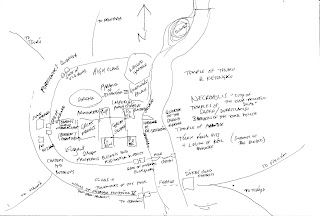In Tsolyánu, High Cartograhy is an Art. Stones are fashioned so that by size, colour and minute details of shape they provide information that one skilled in the art can "read" the stone and learn details of population, taxes, etc.
Here is a passage from A Man of Gold, by the late MAR Barker:
Prior Haringgáshte pulled himself to his feet and extracted a worn leathern case of
map-symbols from the litter of documents on his work table.
From this he took out a small pyramid of blue lapis lazuli. Tiny knobs and loops
of gold had been affixed here and there upon its surface, and flecks of other minerals
glinted from within. This, Hársan knew, symbolised the Empire of Tsolyánu, and
each protuberance, curve, subtle shading, and texture told its tale of cities, roads and
distances, populations, products, villages and towns, and other data, readable only by
those skilled in High Cartography. Next emerged an oblong of sand-yellow jasper: the
desert lands of Milumanayá to the north of Tsolyánu. Beyond this he set out a faceted
rhomboid of smooth green serpentine; this stood for the hostile lands of Baron Áld of
Yán Kór. Above this a tablet of wavy blue slate was placed to indicate the crag-coasted
northern sea, each serration, curve, and change of texture marking a harbour, a cove, an
island, a distant settlement-even reefs and tides. Three smaller polyhedrons of carnelian,agate, and red porphyry were arranged to the left of this to represent the little northern
states of Pijéna, Ghatón, and N’lüss. The Prior then brought forth a cloudy wine-red
dodecahedron of bloodstone which stood for the sprawling empire of Mu’ugalavyá,
Tsolyánu’s sometimes hostile western neighbour beyond the Cháka Range. Below this
he added a curiously twisted moon-shaped symbol of rippling fire opal: the far-off land
of Livyánu. A final plaque of wavy slate to the right of the symbol for Livyánu and
beneath that of Tsolyánu signified the southern ocean, the Deeps of Chanayága. The
rest of the symbols he left in the case.
“Can you read these, then, priest Hársan?”
“Only the rudiments, my Lord. I am more comfortable with the maps drawn upon
paper by merchants – not with these of the High Cartography.”
The Prior’s lips sketched a thin smile. “These tell much more. To see, to touch, to
feel – so much more than flat lines upon a page. Come, show me where the Empire of
Llyán of Tsámra once lay.”
Wondering, Hársan put forth a tentative finger and touched the empty space
between the symbols for Mu’ugalavyá and Livyánu. “Here, my Lord.”
The Prior reached into the welter of materials on the table, picked up a small casket
of dun-red metal, and extracted another map symbol. With the air of a mother setting
a morsel of sugary Dmí-root before a child, he laid this in the space marked by Hársan’s
finger. “This was found in a tomb of the Bednálljan Dynasty near our city of Úrmish.
The casket is Fulát – steel – alas, now one of the rarest metals on Tékumel and one of
the most costly therefore. Go ahead, examine it.”






